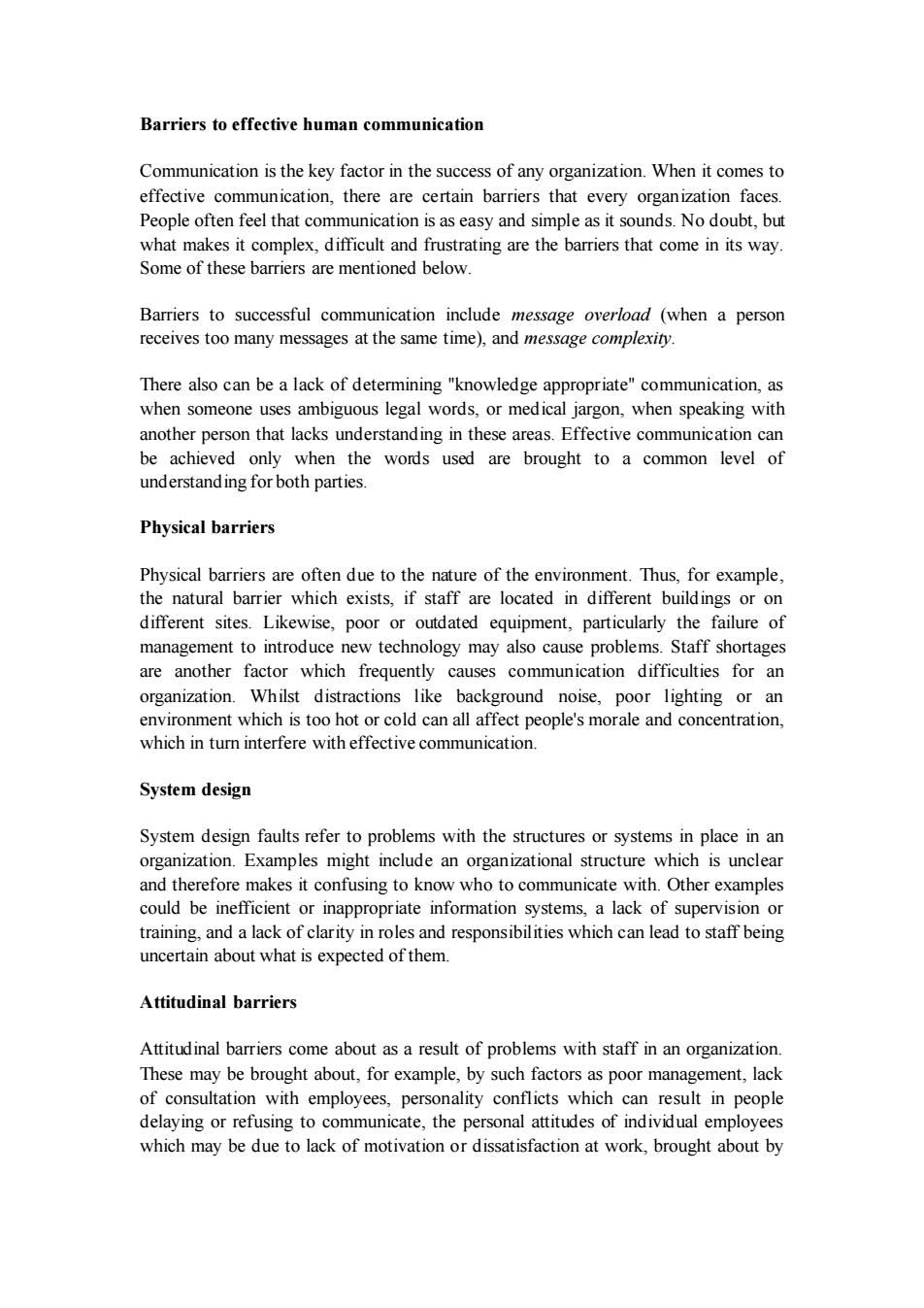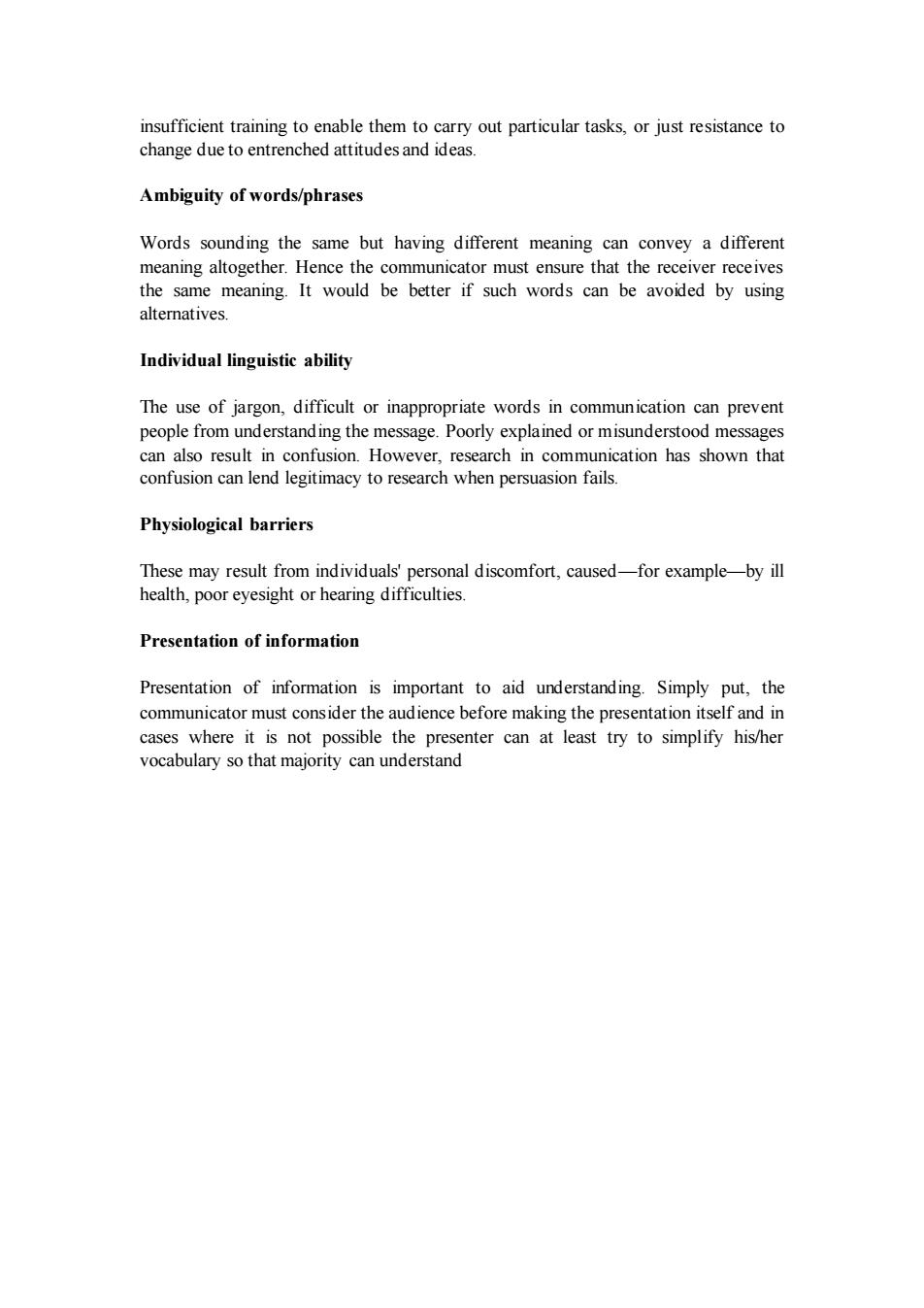
Barriers to effective human communication Communication is the key factor in the success of any organization.When it comes to effective communication,there are certain barriers that every organization faces. People often feel that communication is as easy and simple as it sounds.No doubt,but what makes it complex,difficult and frustrating are the barriers that come in its way. Some of these barriers are mentioned below. Barriers to successful communication include message overload (when a person receives too many messages at the same time),and message complexity. There also can be a lack of determining "knowledge appropriate"communication,as when someone uses ambiguous legal words,or medical jargon,when speaking with another person that lacks understanding in these areas.Effective communication can be achieved only when the words used are brought to a common level of understand ing for both parties. Physical barriers Physical barriers are often due to the nature of the environment.Thus,for example, the natural barrier which exists,if staff are located in different buildings or on different sites.Likewise,poor or outdated equipment,particularly the failure of management to introduce new technology may also cause problems.Staff shortages are another factor which frequently causes communication difficulties for an organization.Whilst distractions like background noise,poor lighting or an environment which is too hot or cold can all affect people's morale and concentration, which in turn interfere with effective communication. System design System design faults refer to problems with the structures or systems in place in an organization.Examples might include an organizational structure which is unclear and therefore makes it confusing to know who to communicate with.Other examples could be inefficient or inappropriate information systems,a lack of supervision or training,and a lack of clarity in roles and responsibilities which can lead to staff being uncertain about what is expected of them. Attitudinal barriers Attitudinal barriers come about as a result of problems with staff in an organization. These may be brought about,for example,by such factors as poor management,lack of consultation with employees,personality conflicts which can result in people delaying or refusing to communicate,the personal attitudes of individual employees which may be due to lack of motivation or dissatisfaction at work,brought about by
Barriers to effective human communication Communication is the key factor in the success of any organization. When it comes to effective communication, there are certain barriers that every organization faces. People often feel that communication is as easy and simple as it sounds. No doubt, but what makes it complex, difficult and frustrating are the barriers that come in its way. Some of these barriers are mentioned below. Barriers to successful communication include message overload (when a person receives too many messages at the same time), and message complexity. There also can be a lack of determining "knowledge appropriate" communication, as when someone uses ambiguous legal words, or medical jargon, when speaking with another person that lacks understanding in these areas. Effective communication can be achieved only when the words used are brought to a common level of understanding for both parties. Physical barriers Physical barriers are often due to the nature of the environment. Thus, for example, the natural barrier which exists, if staff are located in different buildings or on different sites. Likewise, poor or outdated equipment, particularly the failure of management to introduce new technology may also cause problems. Staff shortages are another factor which frequently causes communication difficulties for an organization. Whilst distractions like background noise, poor lighting or an environment which is too hot or cold can all affect people's morale and concentration, which in turn interfere with effective communication. System design System design faults refer to problems with the structures or systems in place in an organization. Examples might include an organizational structure which is unclear and therefore makes it confusing to know who to communicate with. Other examples could be inefficient or inappropriate information systems, a lack of supervision or training, and a lack of clarity in roles and responsibilities which can lead to staff being uncertain about what is expected of them. Attitudinal barriers Attitudinal barriers come about as a result of problems with staff in an organization. These may be brought about, for example, by such factors as poor management, lack of consultation with employees, personality conflicts which can result in people delaying or refusing to communicate, the personal attitudes of individual employees which may be due to lack of motivation or dissatisfaction at work, brought about by

insufficient training to enable them to carry out particular tasks,or just resistance to change due to entrenched attitudes and ideas. Ambiguity of words/phrases Words sounding the same but having different meaning can convey a different meaning altogether.Hence the communicator must ensure that the receiver receives the same meaning.It would be better if such words can be avoided by using alternatives. Individual linguistic ability The use of jargon,difficult or inappropriate words in communication can prevent people from understanding the message.Poorly explained or misunderstood messages can also result in confusion.However,research in communication has shown that confusion can lend legitimacy to research when persuasion fails. Physiological barriers These may result from individuals'personal discomfort,caused-for example-by ill health,poor eyesight or hearing difficulties. Presentation of information Presentation of information is important to aid understanding.Simply put,the communicator must consider the audience before making the presentation itself and in cases where it is not possible the presenter can at least try to simplify his/her vocabulary so that majority can understand
insufficient training to enable them to carry out particular tasks, or just resistance to change due to entrenched attitudes and ideas. Ambiguity of words/phrases Words sounding the same but having different meaning can convey a different meaning altogether. Hence the communicator must ensure that the receiver receives the same meaning. It would be better if such words can be avoided by using alternatives. Individual linguistic ability The use of jargon, difficult or inappropriate words in communication can prevent people from understanding the message. Poorly explained or misunderstood messages can also result in confusion. However, research in communication has shown that confusion can lend legitimacy to research when persuasion fails. Physiological barriers These may result from individuals' personal discomfort, caused—for example—by ill health, poor eyesight or hearing difficulties. Presentation of information Presentation of information is important to aid understanding. Simply put, the communicator must consider the audience before making the presentation itself and in cases where it is not possible the presenter can at least try to simplify his/her vocabulary so that majority can understand